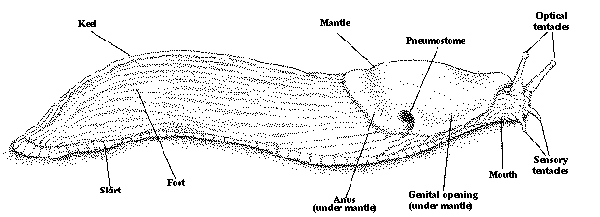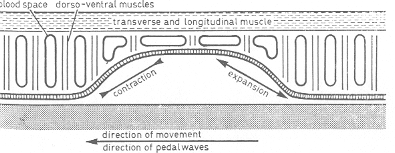MORPHOLOGY The body of a slug is very similar to that of a snail,the most obvious difference being the abscence of a shell.This is not entirely true however,slugs still have some form of a shell.Sometimes this is a form of plate,lying below the mantle(Limacidae), in other cases there are chalky granules(Arionidae). The semi-slugs are a sort of intermediates between snails and slugs.They posses shells,but these are too small to house the whole body. Slugs don't have a visceral mass,their organs are situated on top of the foot. Behind the head is the mantle,this has a different size and color pattern in each species,and forms an important identification point. The part behind the mantle to the tail end is the back.This can have a rounded profile(Arionidae) or have a sharp keel(Limacidae). The sides can have a foot fringe(or skirt) where they meet the sole.The color of the sides and the foot fringe is another important identification point.
DIGESTION When feeding the radula of the slug shreds the food to little pieces,which go into the buccal cavity and the oesophagus.There are getting mixed with mucus and saliva.The foodthen goes into the crop where a large amount of juice is produced by the digestive gland. The enzymes and the food are getting mixed by peristaltic movements of the crop wall. Fats,proteins and polysaccharides are digested,and fatty acids absorbed through the crop wall.Food mixed with crop juice enter the stomach at intervals,fine material passes into the digestive glands.The larger pieces go to the intestinal groove where they are collected to be excreted.In the cells of the digestive gland digestion of the finer parts takes place.Non-digested material leaves the digestive gland in mucus-string. In the stomach the excrements are losely gathered material,but when they go into the intestine they become more packed together and enveloped in mucus. When they travel further in the intestine more mucus is added. The excrements leave the body through the anus.
SENSES Like snails slugs have most of their sensory receptors concentrated around the head.Nerve knots,also named ganglia,process information gathered from the two pairs of tentacles.The lower,shorter,pair,the sensory tentacles, is used for smelling and maybe tasting.The upper,longer,pair,the optic tentacles is sensitive to light and smell.Although slugs can't see colors,they are able to distinguish light from dark. There are less than a 100 light sensitive cells present(compare to 4000 in Helix)many pigment cells surround each one.A large number of microvilli(see number 11 on the drawing) are at the upper surface.These are probably the areas sensitive to light. The mouth lobes can tell the difference between different surfaces. When a slug loses one of his tentacles it will grow back.For example with Arion ater this takes 1-2 months. From the head nerves stretch through the rest of the body.To the foot to control locomotion,and to the visceral mass.
1.digitate ganglion 2.collar cell 3.olfactory nerve 4.tentacle retractor muscle 5.lateral processed cell 6.lateral oval cell 7.optic nerve 8.accessory retina 9.lens 10.retina retinal cell: 11.microvilli 12.pigment cell 13.light sensitive cell LOCOMOTION If you place a slug or snail on top of glass,and look underneath you'll see light and dark bands moving.These are muscle fibers relaxing and contracting. There are two sets of muscle fibers.One set pulls the slug from the front and pushes it off from the back.At the same time the second set pulls the outer surface of the sole forward.
MUCUS Slugs have two types of mucus: one which is thin and watery comes from the glands of the foot epithelium, the other which is thick and sticky comes from the pedal gland and originates at the front of the foot.The thin mucus is spread out form the centre of the foot to the edges,the thick mucus spreads out from front to back. The whole surface of the body produces also mucus.The pedal gland of Limax is embedded in the foot muscle,in Milax it lies in the haemocoel on top of the foot. Mucus is very important in the slugs life for moving around.Mucus contains fibers which prevents the slug from sliding down vertical surfaces. Because slugs don't have a shell to protect them they use mucus for this purpose. Mucus also prevents the slug from drying out,it absorbs water. In navigation mucus comes also in handy,and some species use slime cords to lower themselves on the ground and during mating(Limacidae). Some species have pigmented mucus,for example yellow in Arion subfuscus.
REPRODUCTION Slugs are hermaphroditic,which means that they have both female and male reproductive organs. Often a slug will follow another slugs mucus trail and eat it.Then the slugs circle around eachother.The genitalia are being pushed out,often visible as a bluish swelling on the right side of the body.The slugs move closer together and the genitalia make contact.Sperm is transferred in the form of spermatophores. The Great Grey Garden slug often mates in midair hanging on a slime cord.

two slugs mating their genitalia are pushed out pictures courtesey of this site. In the case of Bananaslugs something else happens,it is called apophallation. What it means is that one slug will bite off the penis of the other. Because the penis cannot regrow the castrated slug is forced to be "female" and offer eggs.
FERTILISATION AND EGG LAYING The spermatophore passes to the spermatheca where the outer layer is digested and the sperm released.Some of it pass to the hermaphrodite duct where it fertilises the eggs. The place where fertilisation takes place is a part between the hermaphrodite duct and albumen gland,called the fertilisation pocket. Between mating and egg laying is usually a short period,for Agriolimax reticulatus this is 8-10 days and for Arion ater some weeks. In a lot of species self-fertilisation is normal(Agriolimax agrestis,A.meridionalis,A.laevis),although in some species (Agriolimax reticulatus)this is rarely the case. Normally eggs are diposed in holes in the ground.Ofcourse the number of eggs and size depends on the species.Vaginulus borellianus lays 610-1365 eggs in 8-13 batches in a continious string.Agriolimax reticulatus lays about 500 eggs in batches of up to 33 eggs.
Go here for a description of slug species Back to the mainpage

